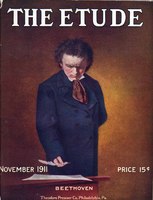BY OSCAR GAUER.
Mendelssohn is rarely thought of as an organist, still he was famous as an organist, and he used to say that one of the few things he could not do was “play the people out of church.”
It is manifestly unfair to any musical composer to attempt to judge him by his less successful efforts. Probably no musical composer, either living or dead—not even excepting such men as Bach, Handel, Mozart or Beethoven—has been equally great in all departments of his art. When ordinary folk think of Handel’s works they generally have in mind his “Messiah”—probably one of the lesser among this composer’s masterpieces(!), certainly not his greatest. When referring to Mendelssohn’s works, the man in the street probably thinks of “Elijah” or of “The Hymn of Praise,” neither of which are really typical of Mendelssohn’s genius. Now, it is quite certain that, great and charming though Mendelssohn’s vocal polyphony is, his true greatness and native genius was in a totally different direction—viz., in his organ works.
Surely every organ student is familiar with his splendid sonatas. As organ pieces they are decidedly sui generis. True, they have in the past been pushed somewhat into the background by Rheinberger’s and by Guilmant’s organ sonatas; and though there is at the present day an enormously increasing output of organ music written, some of it, in what (for want of better term) may be described as “modern” style, replete with fitful melody and uncertain tonality, Mendelssohn’s organ works are still the mainstay of a modern organist’s répertoire. Doubtless, when the up-to-date organist has wandered long and aimlessly through reams of the arid and dry transitional material put forward by modern writers, he will find it refreshing to turn once again to the ever youthful and vigorous organ music of Mendelssohn. It is not the present writer’s purpose here to enter into a lengthy disquisition on Mendelssohn’s organ sonatas. Every organist possesses, or should possess, them; and, seeing that the composer was an enthusiastic student of the great J. S. Bach (“the father of the organist”), it is probably not too much to say that every organ student should endeavor to make himself proficient by having these works, so to speak, at his fingers’ ends, and by making them his “daily bread,” as Schumann has aptly expressed himself in the case of the immortal “Forty-eight” of J. S. Bach.
WORKS SUITABLE FOR STUDENTS.
The writer of these lines wishes to draw the organ student’s attention to the extreme suitability, both as regards length and style, of many of the shorter movements. Take, for instance, the stately and solemn Adagio from the First Sonata. What an extremely devotional little piece to play during the more solemn moments of a service! Then what an appropriate opening to some solemn function is made by the first movement of Sonata Two, with its pathetic and extremely plaintive adagio melody in C minor! The Andante Tranquillo (in A major) of the Third Sonata vies with the last piece in the pathos and the solemnity of its effect. On the other hand, the Andante Religioso of the Fourth Sonata, though true to its designation, has about it somewhat of the character of a lied ohne worte, having much in common with this composer’s pianoforte Lieder. The Andante con Moto from the Fifth Sonata, with its pizzicato pedal work, is quite unique even amongst modern organ pieces. Nothing exactly like it, as far as the writer is aware, exists among organ pieces, excepting only Lemare’s well-known Andantino in D-flat, to which it bears some faint resemblance; and, of course, No. 2 Variation of Mendelssohn’s Sixth Sonata. Coming finally to the Sixth Sonata, we have a short lyrical piece that, in tenderness of effect and in ethereal beauty combined with devotional feeling, is unsurpassed by anything that has ever been written for the organ; in other words, this is simply perfection as an organ andante. Concerning the loud movements of Mendelssohn it is scarcely necessary to speak.
Going back to the First Sonata, we have Dr. A. L. Peace’s testimony to the effect that Allegro Assai Vivace is “one of the finest organ pieces ever written, being absolutely sui generis—the only thing of its kind.” This will no doubt be readily conceded by every skilful and accomplished player. The same might easily be said of the fine Allegro Majestoso of the Second Sonata, with its extremely effective pedal work and the similarly styled loud movement of Sonata Five. The last variation (marked allegro molto) of Sonata Six might be regarded as an example of Mendelssohn’s brilliant extempore style of organ performance, to which the comparative thinness of the writing seems to give colour. Here possibly, as well as in the First Prelude in C minor, we have a living pattern of Mendelssohn’s style of improvisation, for which he was so famous in his day. As for the fine fugue that follows that prelude (also in C minor) written in twelve-eight time, this fine work seems, in the opinion of the present writer, to have been written by Mendelssohn on the model of J. S. Bach’s celebrated “Fuga a la Giga,” which it closely resembles, both in time, general effect and the remarkable flow of the polyphony.—Musical Opinion.



